Parliamentary Procedures
Presentation of Parliamentary Procedures
The basics are presented with visuals and text.
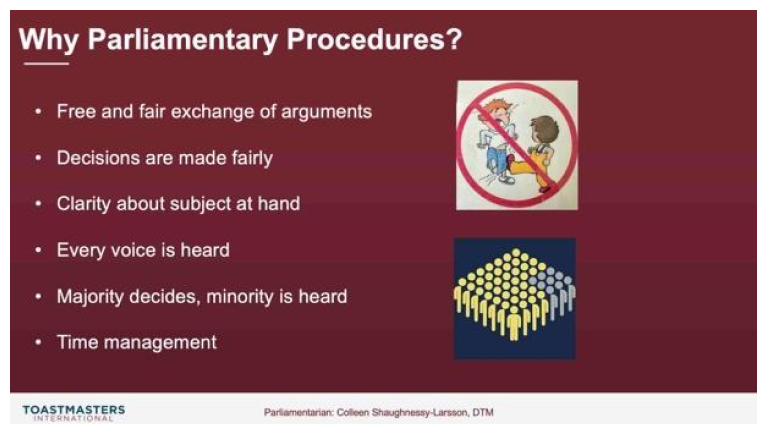
Why have Parliamentary
Procedures?
- Orderliness and structure
- Voices heard in a timely and orderly fashion
- Minority is heard, majority decides
- Following procedures helps time management
The Chair role keeps order and ensures meetings run smoothly. The Parliamentarian helps the chair with the rules, protocol and bylaws. Everything is done in one’s:
- One Topic at a time
- One Speaker at a time
- One Motion at a time
- 30 seconds for each speaker for
- 30 seconds for each speaker against
- Take turns until all have spoken
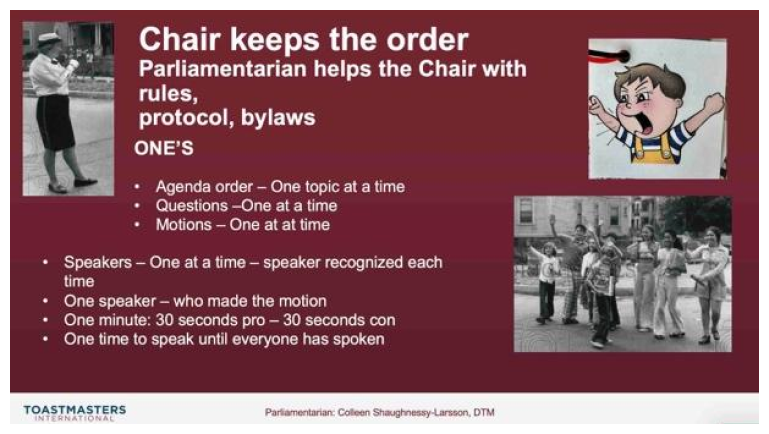
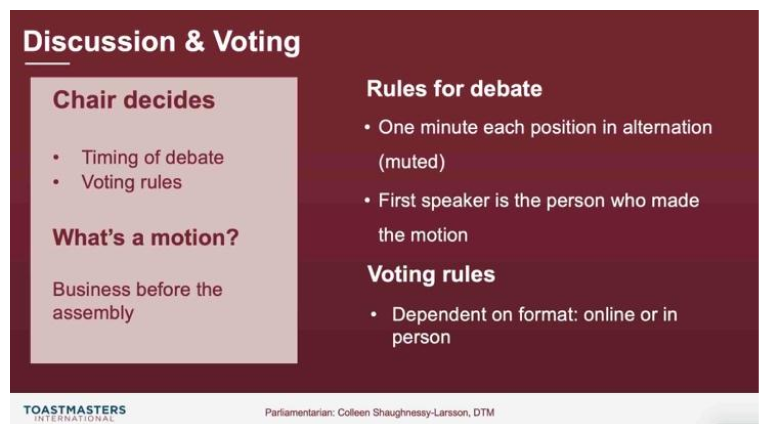
Discussion & Voting
- The Chair decides on debate rules, timing and voting.
- When a member is recognized by the Chair, he/she must state his/her role and name for the record.
- Voting members vote on motions.
- Different format for online and in-person meetings.
What is a Motion?
Any business before the assembly.
Main motions at a District Council Meeting:
1) budget, 2) appointing certain District Officers, 3) elections.
Voting members raise by prior to a District Executive Committee Meeting (DECM)
and the District Council Meeting (DCM).
Robert’s Rules of Order: 23 different motions
The most commonly used motions
– Main Motion
– Amendment to a Main Motion
If the debate becomes repetitive, and the Chair doesn not proceed to a vote, a voting member may seek recognition* from the Chair to end debate.
The member uses a specialized motion “Previous Question” to do this:
“I move the previous question” or
“I move we vote now.”
This motion stops debate on the pending motion, and must be seconded.
*If no one else is in line to speak.
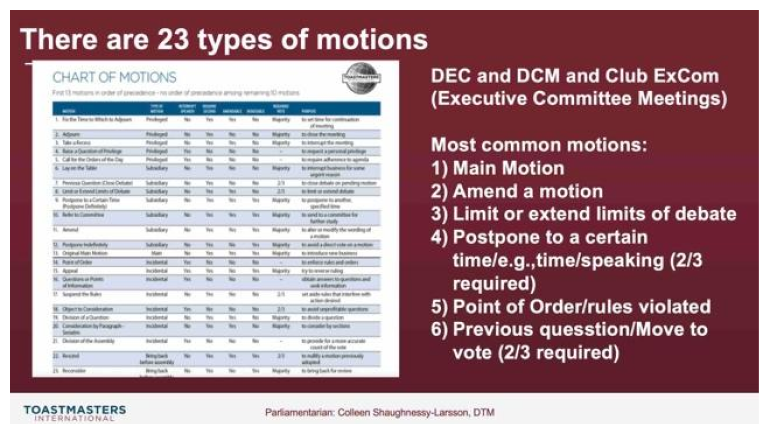
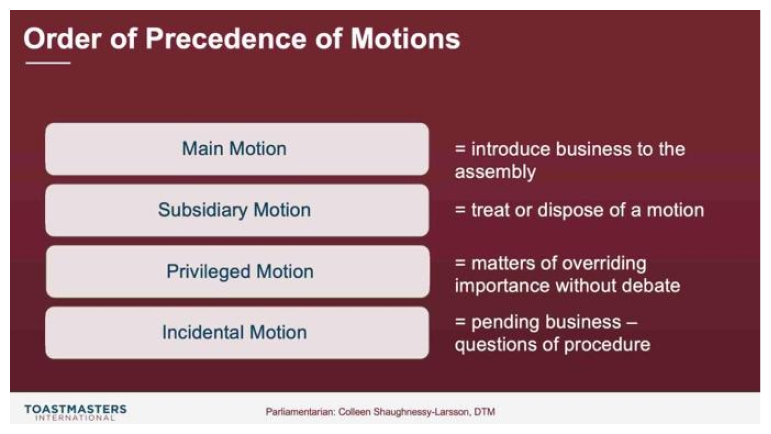
Order of Precedence of Motions
- Main motion: introduces business to the assembly
- Subsidiary motion: treats or disposes of a motion, e.g., amend, postpone, commit to a committee, limit or extend limits of debate, etc.
- Privileged motion: matters of overriding importance without debate, e.g., enforce agenda, room issue, recess, adjourn, etc.
- Incidental motion: pending business, questions of procedure, e.g., point of order, request for information/point of information, appeal, suspend the rules, etc.
Six-step process to make a motion or speak
- A voting member makes a motion.
- Any other member seconds (no need for ID).
- The Chair states (reads) the motion.
- The Chair opens debate.
- The Chair calls for a vote.
- The Chair states the result and reads the new motion.
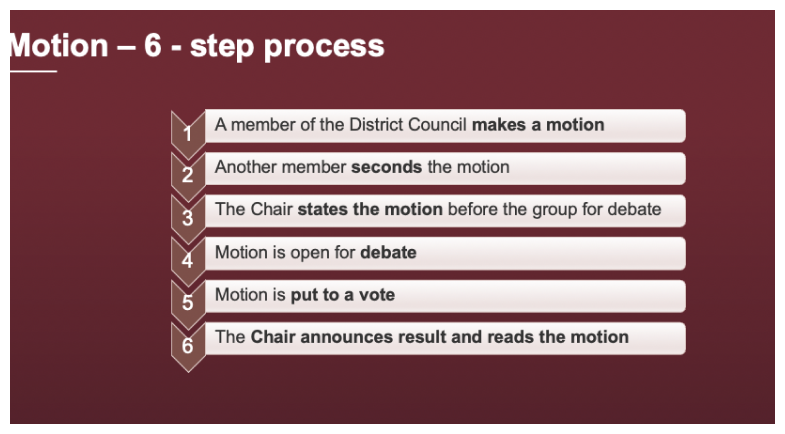
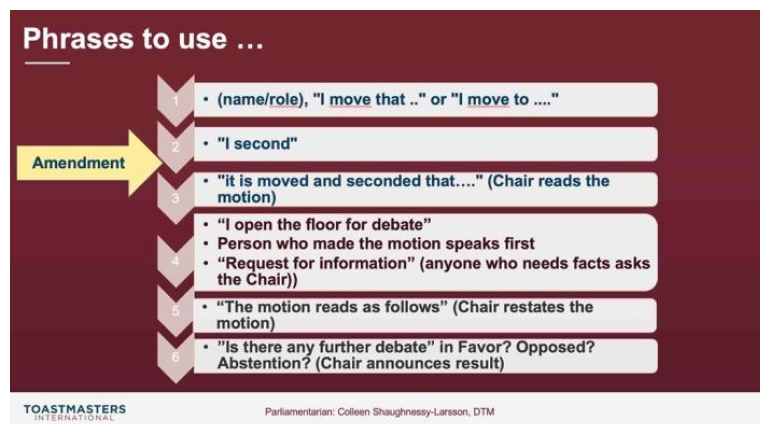
Select phrases to use during a meeting
- “I move that” or “I move to” (the Chair may help word a motion, if necessary).
- “I second” (no need for ID).
- “Request for information” if facts are needed on a topic (no need to raise hand).
- “I move the previous question” closes debate on a pending motion and requires a second, if debate is going on too long.
- “Point of Order” if the rules are not being followed.
Most common amendments
- Insert or add words.
- Strike out words.
- Strike out and insert words.
- Substitute or changes the motion wording in general.
- Amendment to an amendment: better to vote down the original amendment and propose a different version.
- Maximum TWO amendments per motion.
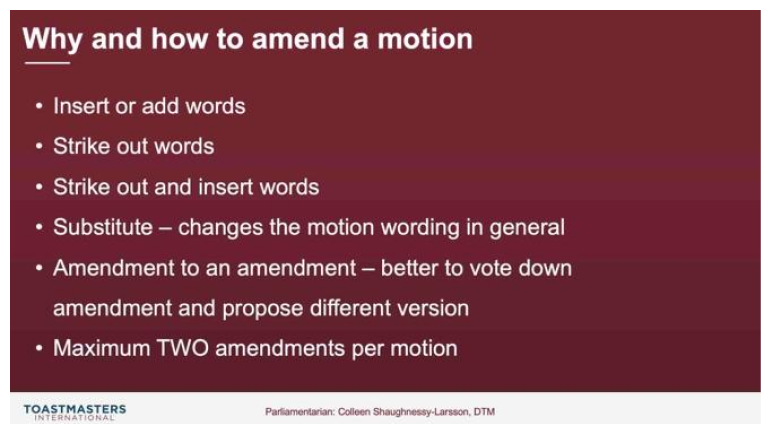
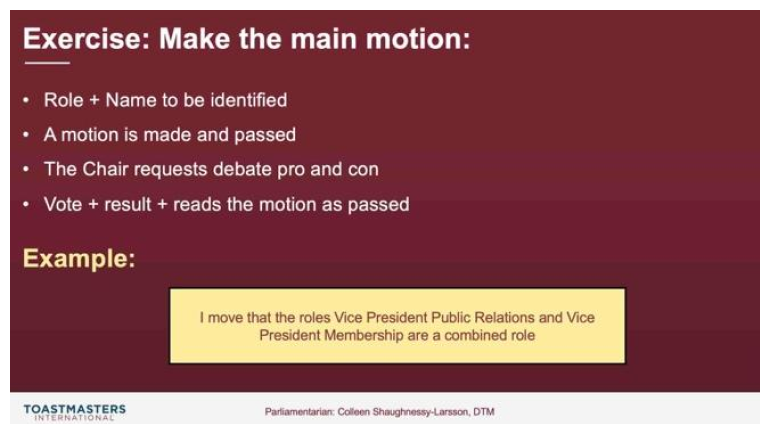
Simple Motion
- Member states role + name to be recognized
- Member makes a motion
- Any other voting member seconds (no need for ID)
- The Chair requests debate pro and con
- The Chair calls for a vote
- The motion passes or fails
- The Chair reads the motion for the record
Amending a Motion
Example:
A voting member moves to amend the wording of a motion:
“I move to amend the motion by striking the words “be a combined role,” and inserting “are two separate roles.”
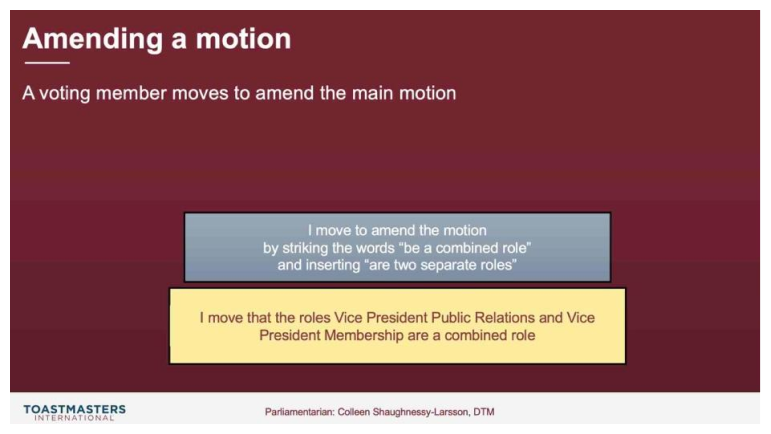
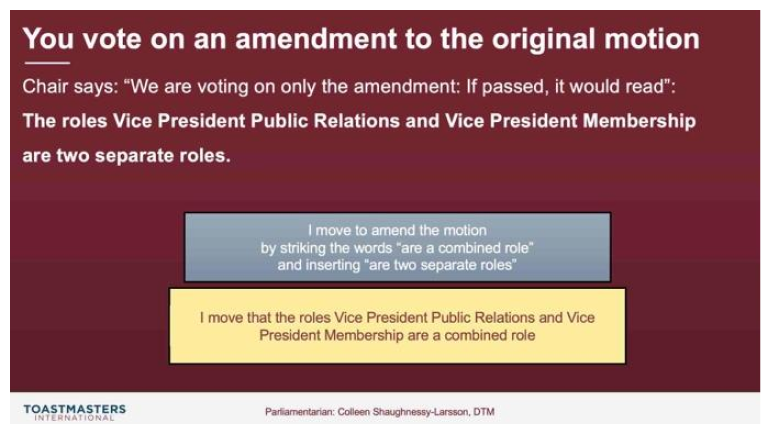
Motion to amend: The vote is on the amendment, not the original motion
Chair: “The amended motion reads:
The roles Vice President Public Relations and Vice President Membership are two separate roles.”
Chair: “Is there any further debate?”
Debate and vote on an amendment to a main motion:
- The Chair calls for debate
- The Chair calls for a vote
- If the Amendment passes, the Chair restates the amended motion for the record: “The roles Vice President Public Relations and Vice President Membership are two separate roles.”
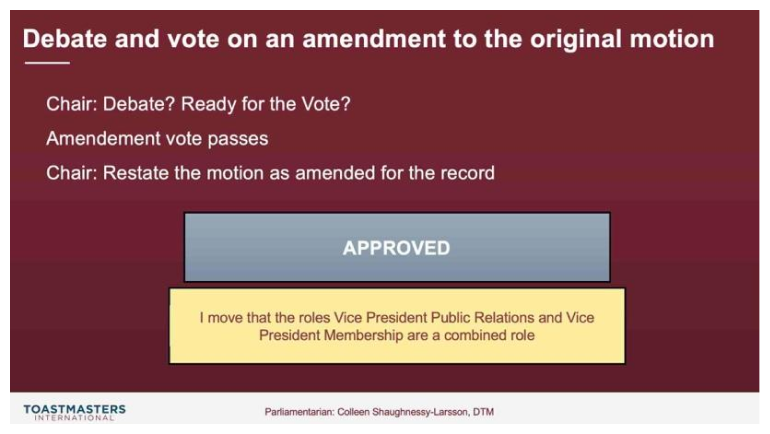
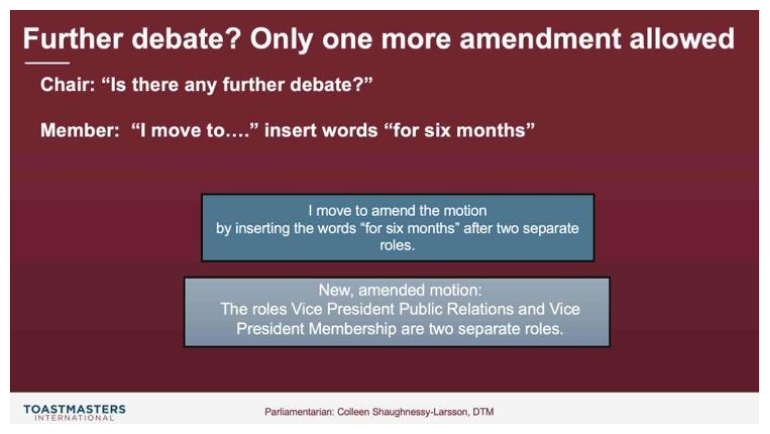
Only two potential amendments of a single motion
- The Chair recognizes a voting member
- Member: “I move to amend the amendment of the motion by inserting the words ‘for six months’ after the words ‘two separate roles’.”
- If this second amendment is not seconded by a voting member, the proposed amendment fails
Amendment rejected
- If a proposed amendment is not seconded, it fails.
- The Chair reads the main motion into the record: “The roles Vice President Public Relations and Vice President Membership are two separate roles.”
This procedure might seem time-consuming, but is ultimately efficient and helps to prevent conflict within your ExCom
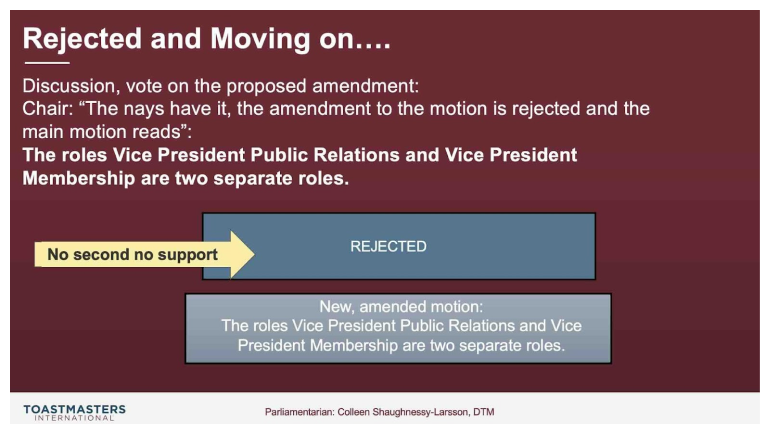
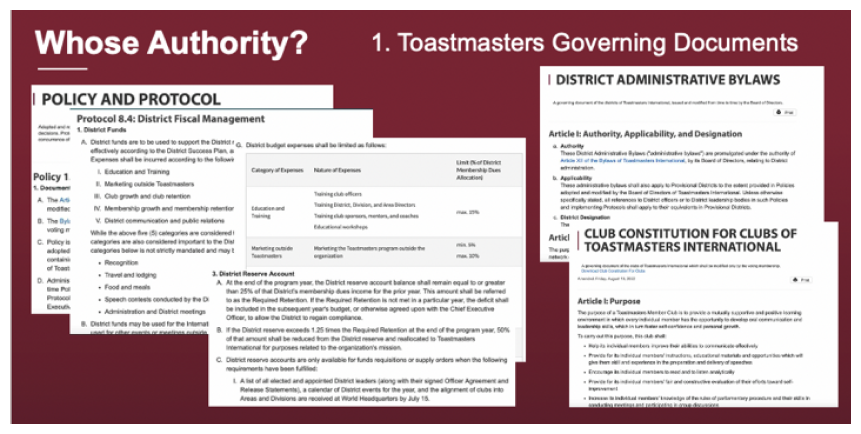
Governing Authorities
All Toastmasters members are ruled by Governing Documents found on the Toastmasters International website.
Clubs are governed by the Club Constitution. Your Club adds its own by-laws to the Club Constitution.
The District is governed by District Administrative By-Laws.
Policy and Protocol govern:
– How your membership dues are distributed
and managed within the District
– Percentages and levels of priority for spending.
– Roles of District Leaders
– Election and contest procedures
– Disciplinary action, etc.
The second authority is Robert’s Rules of Order
Toastmasters International uses Robert’s Rules of Order for Parliamentary Procedure.
In San Francisco, General Robert experienced infighting in assemblies and church gatherings.
Using British and US Congress Parliamentary procedures, he wrote procedures for the common person in 1876.
If you want to know more about Parliamentary Procedures or are interested in becoming the District 59 Parliamentarian, write to parliamentarian@district59.org.
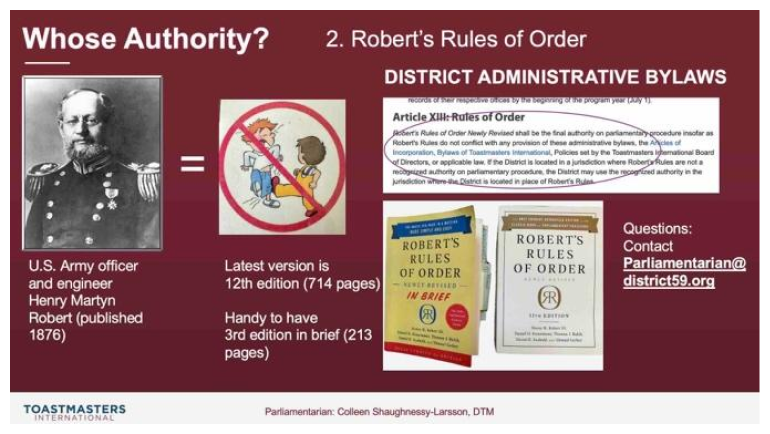
Rhythm of the Motion song by Marijke, Past Parliamentarian and District Director
The Rhythm of the Motion
I move (right hand up)
I second (left hand up)
It has been moved and seconded (head and arms)
I open the floor for discussion (arms wide open)
In favor (point), opposed (point), in favor (point), opposed (point)
Proceed to the vote (turn hands over)
Opposed (right hand up), in favor (left hand up), abstentions (right hand up)
Carried (thumbs up) or failed (thumbs down)

